Since a good bug out bag is supposed to provide the most basic needs of its owner and reflect the most likely emergency scenarios, it should be modified throughout the year to match the current season. Just as your sleeping bag and clothing choices change from summer excursions to winter campouts, so should the contents of your bug out bag. If you’re forward thinking enough to own a B.O.B., then consider altering it in these three areas for the dead of winter.
Clothing
The clothes on your back are your first line of defense against winter’s grip. The last thing you want to see upon opening your bag in February is a pile of shorts and T-shirts. Instead, stock your bag with wool or synthetic-fiber clothing that can be layered for different temperatures and conditions. These materials will not hold moisture the way that cotton does. Saturated clothing is a terrible thing. It conducts heat away from your body and leads to hypothermia. Throw away your cotton long johns. If it is cold enough for long underwear, the last thing you want next to your skin is cotton. Gloves are another important article of clothing that often gets overlooked. Gloves save your hands from the constant wear and tear of survival tasks. Also, exposed fingertips are often the first part things to get frostbite in extreme cold. Select gloves that are waterproof and insulated for cold-weather use. Finally, put some warm headwear in the bag, since the human body loses a lot of heat through an uncovered head.
Sleeping Bag
This part is simple. Toss a zero-degree or sub-zero sleeping bag in your B.O.B. On the downside, these sleeping bags are big, heavy, and expensive. It might even be so bulky you’ll need to strap it to the exterior of the pack. But on the plus side, there are few things that will help you more during a winter emergency than a bag built for the cold. A space blanket just isn’t going to cut it in the dead of winter.
Water
Be ready for a freeze. If you stock bottles of water in your B.O.B. (which you should do), make sure they are thin-walled and can handle the expansion caused by freezing. I’ve lost a few nice water bottles over the past few winters because they froze and burst. You can still keep larger bottles, but leave them empty during storage. Instead, buy a few 16- ounce water bottles from the store, already filled with water. These can expand and contract many times before the plastic even thinks about cracking. Another winter water issue to consider is your disinfection method. Unless you plan on sleeping with your water filter to keep it from freezing up, you’ll want to add some disinfection tablets to your gear for cold winter conditions.
Is your B.O.B. ready for the deep freeze?
Tell us what you did to winterize it in the comments.













